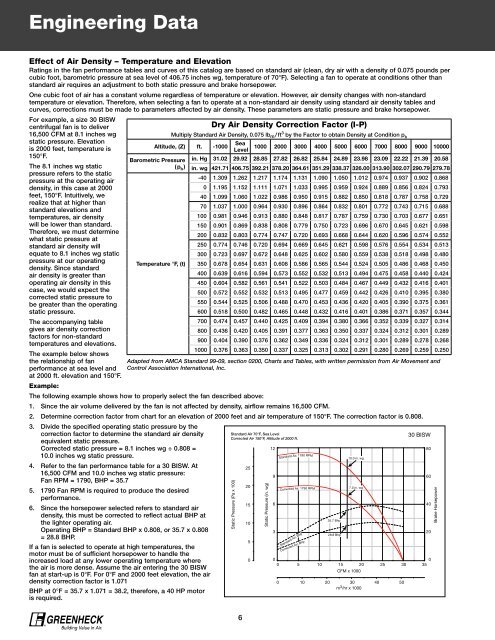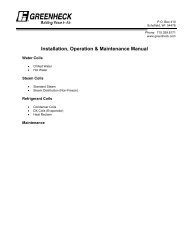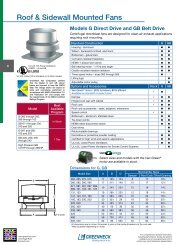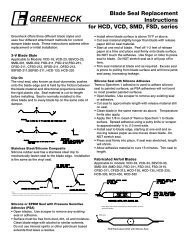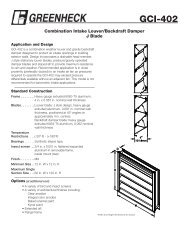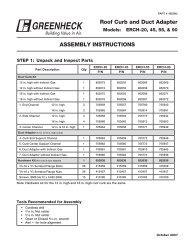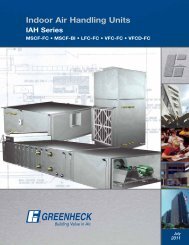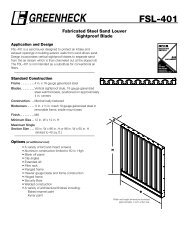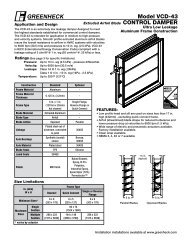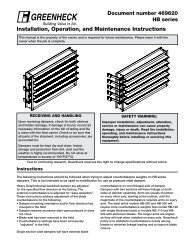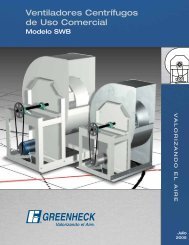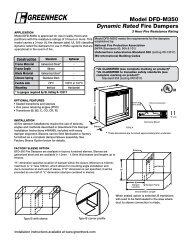Single-Width Centrifugal Fan Performance Supplement - Greenheck
Single-Width Centrifugal Fan Performance Supplement - Greenheck
Single-Width Centrifugal Fan Performance Supplement - Greenheck
You also want an ePaper? Increase the reach of your titles
YUMPU automatically turns print PDFs into web optimized ePapers that Google loves.
Engineering Data<br />
Effect of Air Density – Temperature and Elevation<br />
Ratings in the fan performance tables and curves of this catalog are based on standard air (clean, dry air with a density of 0.075 pounds per<br />
cubic foot, barometric pressure at sea level of 406.75 inches wg, temperature of 70°F). Selecting a fan to operate at conditions other than<br />
standard air requires an adjustment to both static pressure and brake horsepower.<br />
One cubic foot of air has a constant volume regardless of temperature or elevation. However, air density changes with non-standard<br />
temperature or elevation. Therefore, when selecting a fan to operate at a non-standard air density using standard air density tables and<br />
curves, corrections must be made to parameters affected by air density. These parameters are static pressure and brake horsepower.<br />
For example, a size 30 BISW<br />
centrifugal fan is to deliver<br />
16,500 CFM at 8.1 inches wg<br />
static pressure. Elevation<br />
is 2000 feet, temperature is<br />
150°F.<br />
The 8.1 inches wg static<br />
pressure refers to the static<br />
pressure at the operating air<br />
density, in this case at 2000<br />
feet, 150°F. Intuitively, we<br />
realize that at higher than<br />
standard elevations and<br />
temperatures, air density<br />
will be lower than standard.<br />
Therefore, we must determine<br />
what static pressure at<br />
standard air density will<br />
equate to 8.1 inches wg static<br />
pressure at our operating<br />
density. Since standard<br />
air density is greater than<br />
operating air density in this<br />
case, we would expect the<br />
corrected static pressure to<br />
be greater than the operating<br />
static pressure.<br />
The accompanying table<br />
gives air density correction<br />
factors for non-standard<br />
temperatures and elevations.<br />
The example below shows<br />
the relationship of fan<br />
performance at sea level and<br />
at 2000 ft. elevation and 150°F.<br />
Example:<br />
The following example shows how to properly select the fan described above:<br />
1. Since the air volume delivered by the fan is not affected by density, airflow remains 16,500 CFM.<br />
2. Determine correction factor from chart for an elevation of 2000 feet and air temperature of 150°F. The correction factor is 0.808.<br />
3. Divide the specified operating static pressure by the<br />
correction factor to determine the standard air density<br />
equivalent static pressure.<br />
30 BISW<br />
Corrected static pressure = 8.1 inches wg ÷ 0.808 =<br />
10.0 inches wg static pressure.<br />
4. Refer to the fan performance table for a 30 BISW. At<br />
16,500 CFM and 10.0 inches wg static pressure:<br />
<strong>Fan</strong> RPM = 1790, BHP = 35.7<br />
5. 1790 <strong>Fan</strong> RPM is required to produce the desired<br />
performance.<br />
6. Since the horsepower selected refers to standard air<br />
density, this must be corrected to reflect actual BHP at<br />
the lighter operating air.<br />
Operating BHP = Standard BHP x 0.808, or 35.7 x 0.808<br />
= 28.8 BHP.<br />
If a fan is selected to operate at high temperatures, the<br />
motor must be of sufficient horsepower to handle the<br />
increased load at any lower operating temperature where<br />
the air is more dense. Assume the air entering the 30 BISW<br />
fan at start-up is 0°F. For 0°F and 2000 feet elevation, the air<br />
CFM x 1000<br />
density correction factor is 1.071<br />
BHP at 0°F = 35.7 x 1.071 = 38.2, therefore, a 40 HP motor<br />
is required.<br />
m3 Standard Air 70°F, Sea Level<br />
Corrected Air 150°F, Altitude of 2000 ft.<br />
12<br />
80<br />
10.0 in. wg<br />
25<br />
9<br />
60<br />
20<br />
7.0 in. wg<br />
15<br />
6<br />
40<br />
10<br />
35.7 Bhp<br />
5<br />
3<br />
28.8 Bhp<br />
20<br />
0<br />
0<br />
0 5 10 15 20 25 30<br />
0<br />
35<br />
0 10 20 30 40 50<br />
/hr x 1000<br />
®<br />
Dry Air Density Correction Factor (I-P)<br />
Multiply Standard Air Density, 0.075 lbm / ft 3 by the Factor to obtain Density at Condition pb Altitude, (Z) ft. -1000<br />
Sea<br />
Level<br />
1000 2000 3000 4000 5000 6000 7000 8000 9000 10000<br />
Barometric Pressure in. Hg 31.02 29.92 28.85 27.82 26.82 25.84 24.89 23.98 23.09 22.22 21.39 20.58<br />
( pb ) in. wg 421.71 406.75 392.21 378.20 364.61 351.29 338.37 326.00 313.90 302.07 290.79 279.78<br />
-40 1.309 1.262 1.217 1.174 1.131 1.090 1.050 1.012 0.974 0.937 0.902 0.868<br />
0 1.195 1.152 1.111 1.071 1.033 0.995 0.959 0.924 0.889 0.856 0.824 0.793<br />
40 1.099 1.060 1.022 0.986 0.950 0.915 0.882 0.850 0.818 0.787 0.758 0.729<br />
70 1.037 1.000 0.964 0.930 0.896 0.864 0.832 0.801 0.772 0.743 0.715 0.688<br />
100 0.981 0.946 0.913 0.880 0.848 0.817 0.787 0.759 0.730 0.703 0.677 0.651<br />
150 0.901 0.869 0.838 0.808 0.779 0.750 0.723 0.696 0.670 0.645 0.621 0.598<br />
200 0.832 0.803 0.774 0.747 0.720 0.693 0.668 0.644 0.620 0.596 0.574 0.552<br />
250 0.774 0.746 0.720 0.694 0.669 0.645 0.621 0.598 0.576 0.554 0.534 0.513<br />
300 0.723 0.697 0.672 0.648 0.625 0.602 0.580 0.559 0.538 0.518 0.498 0.480<br />
Temperature °F, (t) 350 0.678 0.654 0.631 0.608 0.586 0.565 0.544 0.524 0.505 0.486 0.468 0.450<br />
400 0.639 0.616 0.594 0.573 0.552 0.532 0.513 0.494 0.475 0.458 0.440 0.424<br />
450 0.604 0.582 0.561 0.541 0.522 0.503 0.484 0.467 0.449 0.432 0.416 0.401<br />
500 0.572 0.552 0.532 0.513 0.495 0.477 0.459 0.442 0.426 0.410 0.395 0.380<br />
550 0.544 0.525 0.506 0.488 0.470 0.453 0.436 0.420 0.405 0.390 0.375 0.361<br />
600 0.518 0.500 0.482 0.465 0.448 0.432 0.416 0.401 0.386 0.371 0.357 0.344<br />
700 0.474 0.457 0.440 0.425 0.409 0.394 0.380 0.366 0.352 0.339 0.327 0.314<br />
800 0.436 0.420 0.405 0.391 0.377 0.363 0.350 0.337 0.324 0.312 0.301 0.289<br />
900 0.404 0.390 0.376 0.362 0.349 0.336 0.324 0.312 0.301 0.289 0.278 0.268<br />
1000 0.376 0.363 0.350 0.337 0.325 0.313 0.302 0.291 0.280 0.269 0.259 0.250<br />
Adapted from AMCA Standard 99-09, section 0200, Charts and Tables, with written permission from Air Movement and<br />
Control Association International, Inc.<br />
Static Pressure (Pa x 100)<br />
6<br />
Static Pressure (in. wg)<br />
Standard Air, 1790 RPM<br />
Corrected Air, 1790 RPM<br />
Standard Air, Bhp<br />
Corrected Air, Bhp<br />
Brake Horsepower


